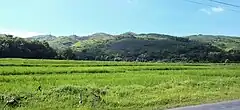Kabuh Formation
The Kabuh Formation is a Plio-Pleistocene geologic formation from Central Java, consisting of several unnamed members belonging to the Kendeng Group.[1] Many of the fossils discovered from Sambungmacan belonging to this group were discovered in an accumulated sediment deposit in a flood-controlling canal near the Solo River, including a series of hominin crania that are similar in anatomy and geologically younger than the Ngandong hominins upstream. This area was excavated throughout the 1970s.[2][3][4][5][6]
| Kabuh Formation | |
|---|---|
| Stratigraphic range: Zanclean–Chibanian ~ | |
 | |
| Type | Geological formation |
| Unit of | Kendeng Group |
| Lithology | |
| Primary | Sandstone, mudstone |
| Location | |
| Coordinates | 7.5°S 110.0°E |
| Approximate paleocoordinates | 7.6°S 110.4°E |
| Region | Java |
| Country | Indonesia |
Fauna
Gastropoda
| Genus | Species | Group | Material | Notes |
|---|---|---|---|---|
| Calyptraea (Bicatillus)[1] | morbidum | Kendeng | ||
| Cerithium[1] | bioekense | |||
| Cerithidea (Cerithideopsilla)[1] | cf. microptera | |||
| cheribonensis | ||||
| jenkinsi |
References
- Kabuh Formation at paleobiodb.org
- Kaifu, Yousuke; Baba, Hisao; Aziz, Fachroel (2006). "Indonesian Homo erectus and Modern Human Origins in Australasia: New Evidence from the Sambungmacan Region, Central Java" (PDF). Proceedings of the 7th and 8th Symposia on Collection Building and Natural History Studies in Asia and the Pacific Rim. 34: 289–294.
- Márquez, Samuel; Mowbray, Kenneth; Sawyer, G J; Jacob, Teuku; Silvers, Adam (2001-04-01). "New fossil hominid calvaria from Indonesia-Sambungmacan 3: SM 3 Calvaria". The Anatomical Record. 262 (4): 344–368. doi:10.1002/ar.1046.
- Baba, Hisao; Aziz, Fachroel; Kaifu, Yousuke; Suwa, Gen; Kono, Reiko T.; Jacob, Teuku (2003-02-28). "Homo erectus Calvarium from the Pleistocene of Java". Science. 299 (5611): 1384–1388. doi:10.1126/science.1081676. ISSN 0036-8075.
- Swisher, C. C.; Rink, W. J.; Antón, S. C.; Schwarcz, H. P.; Curtis, G. H.; Suprijo, A.; Widiasmoro (1996-12-13). "Latest Homo erectus of Java: Potential Contemporaneity with Homo sapiens in Southeast Asia". Science. 274 (5294): 1870–1874. doi:10.1126/science.274.5294.1870. ISSN 0036-8075.
- "Homo erectus of Java: Potential Contemporaneity with Homo sapiens in Southeast Asia". experts.mcmaster.ca. Retrieved 2023-08-09.
- Setiyabudi, Erick; Takahashi, Akio; Kaifu, Yosuke (2016). "First Certain Fossil Record of Orlitia borneensis (Testudines: Geoemydidae) from the Pleistocene of Central Java, Indonesia". Current Herpetology. 35 (2): 75–82. doi:10.5358/hsj.35.75. ISSN 1345-5834.
- Laitman, Jeffrey T.; Tattersall, Ian (2001). "Homo erectus newyorkensis: An Indonesian fossil rediscovered in Manhattan sheds light on the middle phase of human evolution". The Anatomical Record. 262 (4): 341. ISSN 0003-276X.
- "Homo erectus newyorkensis Laitman and Tattersall, 2001". Paleo Core.
This article is issued from Wikipedia. The text is licensed under Creative Commons - Attribution - Sharealike. Additional terms may apply for the media files.
